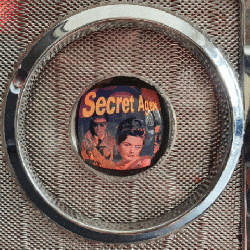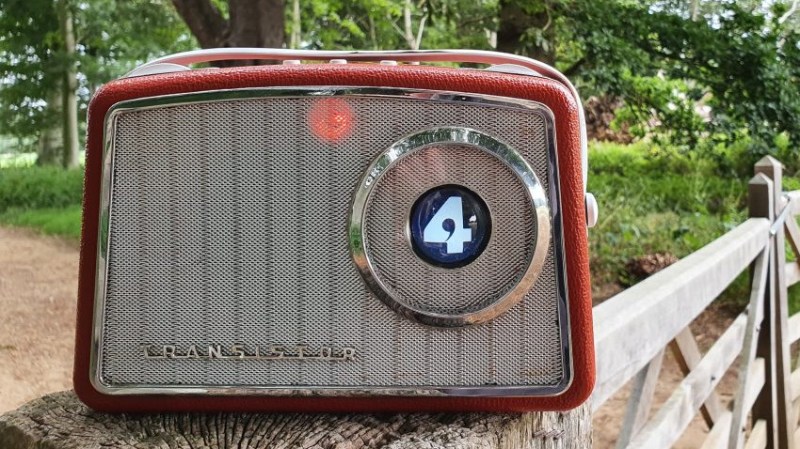There’s nothing quite like vintage hardware, and the way it looks and works is something that can be worth celebrating. [Old Tech. New Spec] did that with his loving modification of a 1964 Dansette portable radio, bringing it into the modern era by giving it the ability to play Internet radio stations while keeping all the original controls and appearance. As he says, you’d hardly know it has been modified unless you turned it on.

A real centerpiece of this conversion is that the inner part of the tuning dial has been replaced with a full color LCD display that shows, among other things, the logo of whatever Internet radio station is currently playing. The combination of LCD and convex lens looks fantastic, and blends beautifully into the aesthetic.
Inside the device is a Raspberry Pi, some simple Python scripts, and a Pirate Audio board. Together, they handle the job of audio streaming and output, displaying album art, and accepting inputs for playback controls. A large power bank ensures the result remains portable, and as usual with vintage hardware, there’s no worry about fitting everything inside. Watch it in action in the video embedded below. (And if the name of the audio board got you excited, but you’re disappointed to discover there’s no actual pirate broadcasting happening? Well, the Raspberry Pi can do that, too.)















Something I never understand: why gutting a nice-looking vintage thing and “bringing it to the modern era”? If it’s good make us listen to it and keep it dear, but if it is not working, repair it and you’ll get (FWIW) kudos. We already have fake modern things into fake (and now this is one) vintage things. Sorry.
For a vintage radio in the UK the choice of non DAB or FM stations is very limited – this way he can listen to stations he wants.
Yeah, when I first saw that, my immediate thought was sacrilege. But, come-on…Japanese transistor era radio. How many of them did they make?
I’m the first to object, when a nice bit of old kit is desecrated. However, in this instance, I feel there’s been a bit of worthy up-cycling employed, with a nice result.
(Hands off the Bakelite though, gang.)
“Japanese transistor era radio”
Dansette is british. Back then most radios in Europe were manufactured locally, there were high tariffs on imports. Japanese radios of that era are actually hard to find here.
RPi, HAH! Could’ve done it with a IBM computing cheese cutter.
I can appreciate the interest in keeping an old thing original. Unfortunately, the content this radio was engineered to play no longer is of the same quality, in the same way a betamax VCR doesn’t really get much play these days. Implementing a hardware upgrade benefits this device in giving it new content. The rPi is benefitted by getting an awesome case and UI, which decreases its tendency to sit idle on a shelf. Same with this old radio… more likely to have a purpose to be used as opposed to sitting as a relic taking up physical shelf space.
I’m OK with it. I have a few that could go that way. It’s late PM for AM, show ends at midnight.
What caught my eye was Illinois Street Lounge on Soma FM! Cheers!
Question. More and more often a link I use from Publicradiofan dot com no longer works and is either dead or goes to a page with a little triangle and sometimes clicking it goes to another page with another little triangle to begin the stream. I use the history in VLC for no-browser instant access to many streams of real radio stations, that seems to be getting cut out now. To listen to one of these new-fangled streams on a phone is a waste of power and then the stream cuts off after the screen cuts off, settings I know but more power is needed. Worst of all they will have a volume control on their end and the default setting is at 50%. What a waste of the given bandwidth!
This more than an inconvenience this gets into ADA access. What about blind internet radio users?
Another one bites the dust.
Another zombie leaves the grave.
Kerbango !!!!
If I had been creating this I would have tried to re-use the rotary tuning dial which could have been pre-marked with the streaming channel names. That would have made it even more “authentic”. Still a nice job.though.
I also made this type od conversion. Search YouTube for: Radio Stolica z 1958 roku
Radio is the first device through which we can easily transmit words from one place to another. Since 1964, vintage radio has been equally popular in the modern Internet age. You can also use this radio to internet radio channels to replace some inner parts. When you replace your old tuning dial with a full color LCD display, then you can access the internet radio channels. The color LCD display shows you what internet radio channel connects with your radio.
I kind-of like this… But that’s not an upgrade : nothing is left from the original radio. I understand the original hardware is pretty obsolete, pretty inefficient energy-wise, and practically useless in DAB-ized areas where no analog FM/AM are available anymore. But there is a distinctive look-n-feel with these vintage radios : rotative dialers, knobs, radio-buttons… Now this is all changed to push-buttons. Even the original ON/OFF/VOLUME knob is turned into a “VOL-” button, but still showing ON/OFF. Thanks anyway. First for saving this old radio from the ditch. And also to help me refine which kind of upgrade I plan to perform on my own vintage radios.